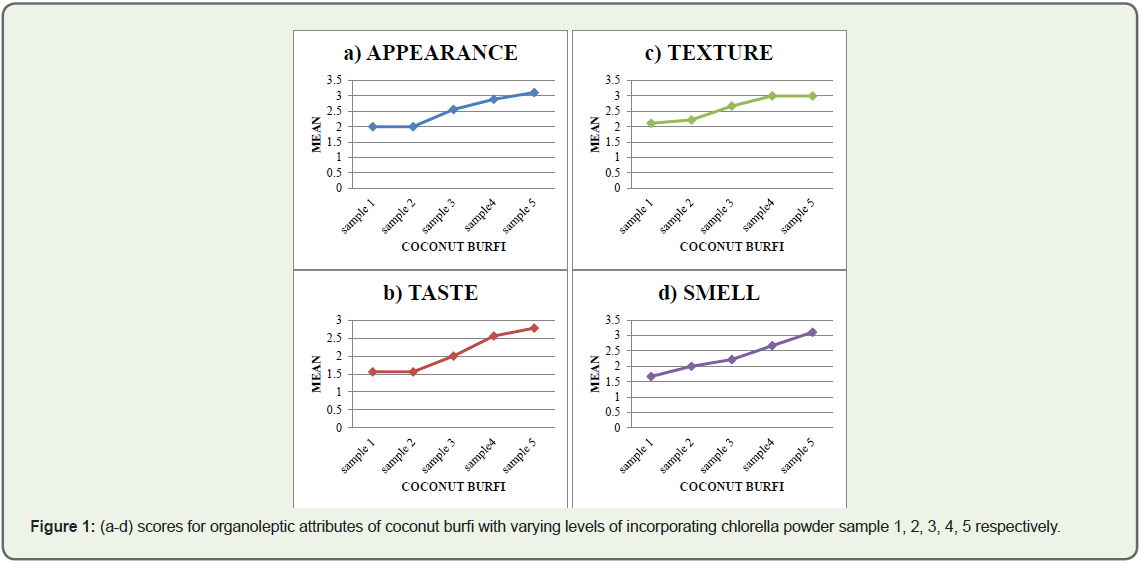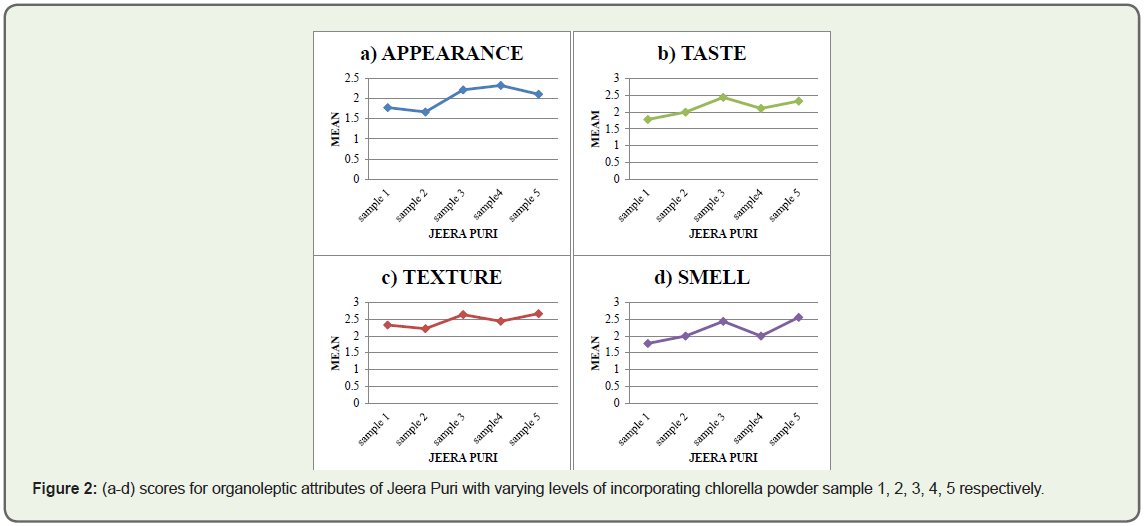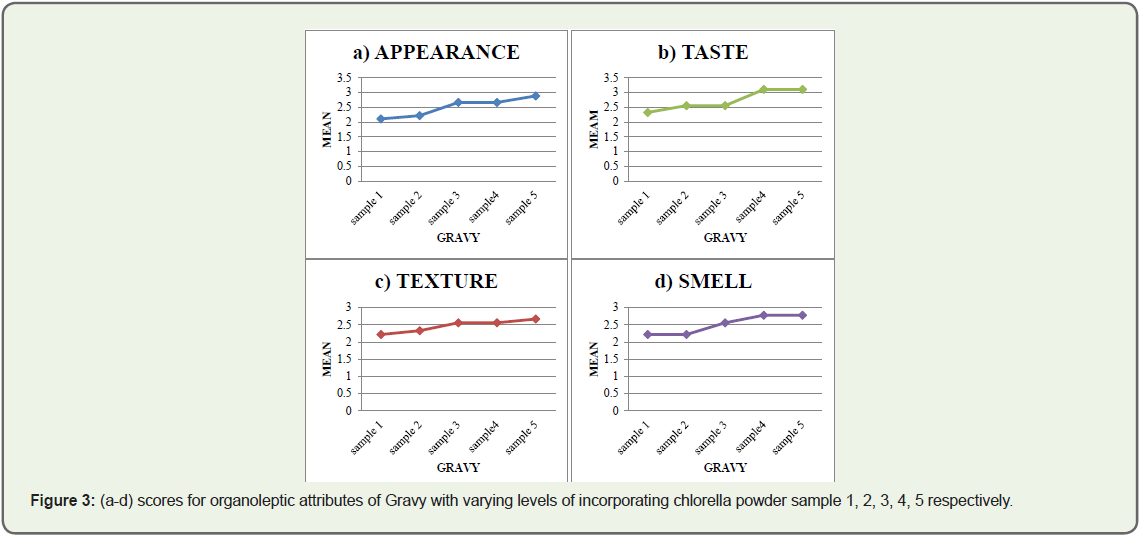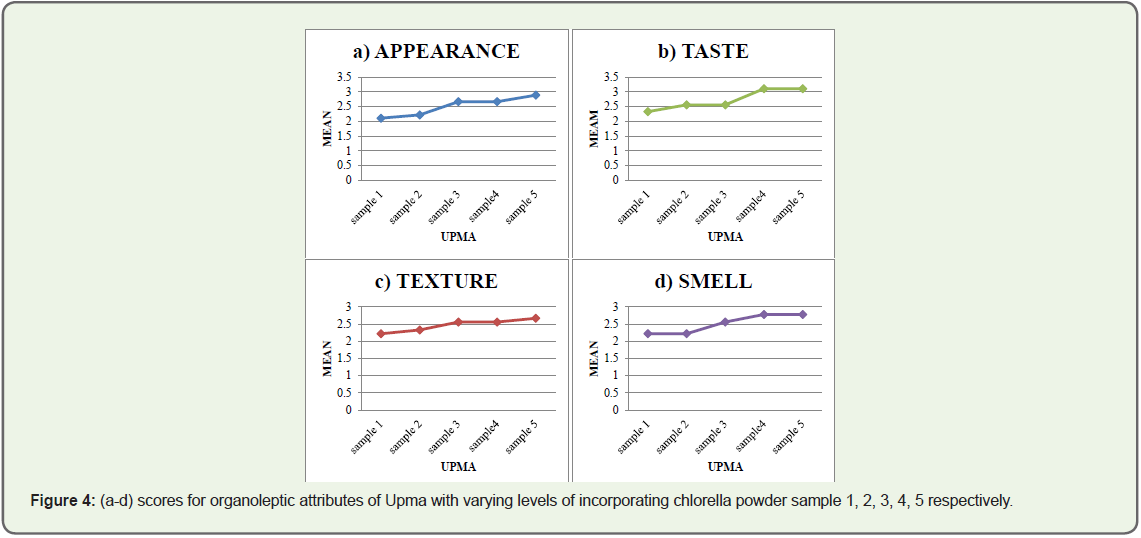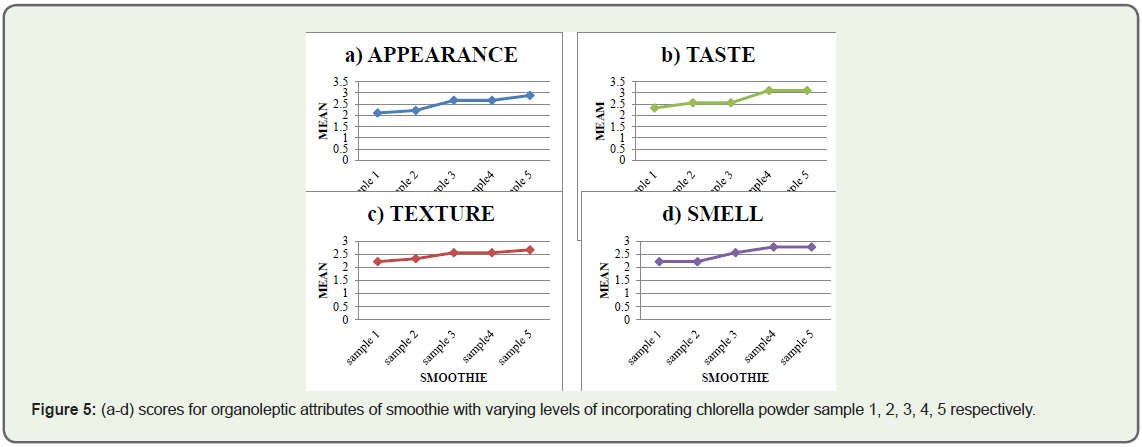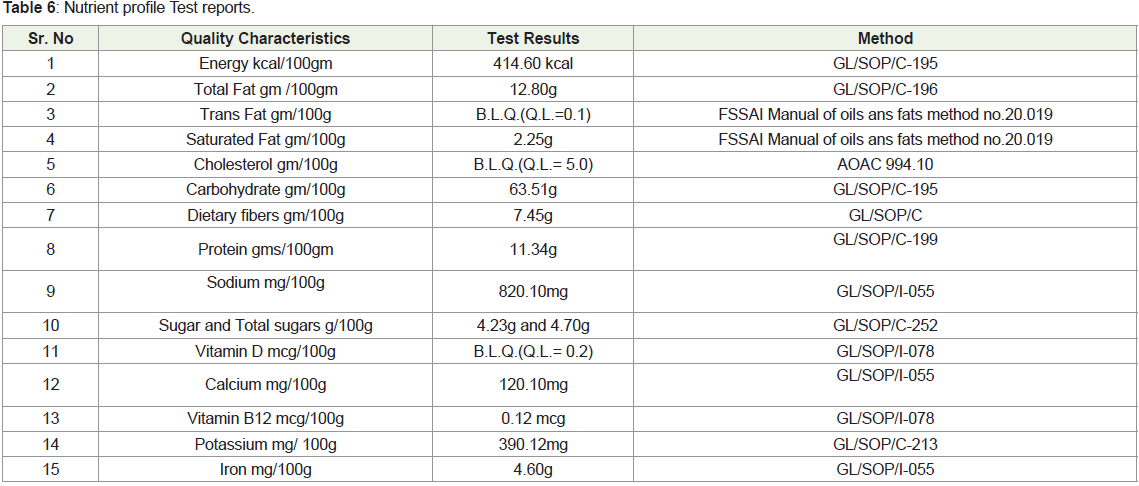Research Article
Determining Vitamin B12 by Incorporating Chlorella Powder in Vegan Recipes
Sahajwani S*and Bhoyra G
Department of Nutrition and Dietetic, Parul University, post limda, Waghodia, Vadodara 391760 Gujarat, India
*Corresponding author: Sahajwani S, Department of Nutrition and Dietetic, Parul University, post limda, Waghodia, Vadodara 391760 Gujarat, India Email: simmisahajwani862@gmail.com
Submission: 03/03/2023; Accepted: 19/04/2023; Published: 24/04/2023
©2023 Sahajwani S, et al. This is an open access article distributed under the Creative Commons Attribution
License, which permits unrestricted use, distribution, and reproduction in any medium, provided the original work is properly
cited
Abstract
Veganism is a diet that consists solely of plant-based foods and products; however, this diet lacks some nutrients, such as vitamin B12, because its
sources are in animal-based foods, and because this diet, animal-based foods, and products have eliminated. People who follow this diet are tent to get vitamin
B12 deficient. Chlorella is an alternative source of vitamin B12 for vegetarians and vegans. Therefore, this study aimed to determine vitamin b12 status by
incorporating Chlorella powder into vegan recipes. Five vegan recipes were selected: Jeera Puri, Vegan Smoothie, Vegan Coconut Burfi, and Upma. In the
statistical analysis, food products containing Chlorella were developed and evaluated. The sensory evaluation was carried out for jeera puri, vegan smoothie,
Vegan coconut burfi and vegan gravy containing 1 g, 2g, 3g and 4g of chlorella powder. The premixes were stored for 3 months (premix) and 1 week (cooked),
and it was observed that there was a significant difference within the groups (pO.05). The F-test revealed differences in the organoleptic score in terms of
appearance, taste, texture and smell at all the levels of incorporation of chlorella powder at varying levels which are appearance- 0.025, taste- 0.016, texture-
0.179 and smell- 0.047 in the gravy premix. In addition, sample 2 of vegan gravy was less preferable, and sample 4 (3 g) was preferred by the panel members
since as per taste was suitable for all. As a result, compared to all premixes, the Gravy premix was the best recipe as it stood out in all attributes such as
appearance, texture, and smell in sensory evaluation.
Keywords: Vegetarianism; Veganism; Vegan recipes; European population; health impact; vitamin b12; vitamin b12 deficiency; alternate source; chlorella
powder
Introduction
Vegetarianism and its different forms have become popular,
including Lacto-vegetarianism, ovo- vegetarianism, lacto-ovovegetarianism,
pescatarians and vegan [1].
Vegan diet is the strictest form of vegetarianism which forbids
all animal origin, including dairy, eggs, meat, and poultry2and is
replaced by plant-based foods. It is often motive by ethical, religious
principles, environmental and health resons3 but vegan diets tend to
be lower in certain nutrients such as long-chain n-3 and vitamin B-
12 vitamin D, calcium, zinc, and vitamin B- 12 while being advanced
in salutary fiber, magnesium, folic acid, vitamins C and E, iron, and
phytochemicals [2-4].
Vitamin B12 (cobalamin) is a water-soluble vitamin which plays
a crucial role in the nervous system, DNA, fatty acids, and myelin
production. Vitamin B12 functions as an enzyme cofactor. It is mostly
found in flesh (especially beef, pork, and organ flesh (e.g., liver), flesh,
milk and milk products [5]. Vitamin B12 deficiency is largely due to
limited intake of animal origin foods or the malabsorption of vitamin.
Vegans can meet their vitamin B12 demands from fortified foods or
supplements. The most common form of vitamin B12 in salutary
supplements is cyanocobalamin [6]. The most chemically stable and
unnatural form of cobalamin is cyanocobalamin [6,7]. A supplement
can be defined as any vitamin, mineral, chemical or botanical or
herbal product that is added to the diet to prevent deficiencies but
many scientists and health professionals agree that supplements
can be taken under certain conditions and moral health but should
not be replace complete and balanced foods that are necessary for
a healthy diet [6]. Soy products such as miso, tempeh, shiitake (dry
mushrooms), chlorella, spirulina, and nori (algae) are the vitamin
b12 vegetarian sources8. Vitamin B12 deficiency is generally seen only among vegetarians or vegans because vitamin b12 is present only in
animal origin foods, but C. vulgaris could be an alternate source for
the vitamin B12 status of vegan [3].
Chlorella is a green unicellular alga found in freshwater [9]. Dr.
Martinus Willem Beijerinck discovered and described Chlorella
vulgaris in 1890, a notorious microbiologist and botanist, it contains
multitudinous nutrients and vitamins, including D and B12, that
are absent in factory-deduced food sources [10]. Examinations
of the vitamin b12 value of Chlorella in mortal health began in
the early 1950s; Chlorella was first produced and consumed in
Asia, substantially in Japan, and also commercially produced and
distributed worldwide as a supplement [10].
Veganism is a particular diet that includes only plant-based foods
and products, however, this diet lacks some nutrients such as vitamin
B12 as its sources are in animal-based foods, and this diet, animalbased
food, and products have eliminated this reason people who opt
for this kind of diet are deficient of vitamin B12. Chlorella vulgaris
will be an alternative source for improving the vitamin B12 status
of vegetarians or vegans so the aim of this study is to determine the
vitamin 12 status in chlorella and incorporate chlorella powder in
vegan recipes.
Materials & Methods
Materials:
The chlorella powder was purchased from Tonga herbs,
Bhubaneswar, Odisha. All the raw ingredients for Vegan Jeera Puri,
Vegan Smoothie, Vegan Coconut Burfi, Vegan Upma and Vegan
Gravy premixes were purchased from Maheshwari store, Surat.Method:
This study is divided into three phases:
Phase 1: Preparation of 5 recipes
A) Outsourcing of chlorella powder: The chlorella powder was purchased from Tonga herbs, Bhubaneswar, Odisha.
B) Preparation and standardization of vegan recipes with the corporation of chlorella powder: Standardization is a process developed to ensure the quality and quantity of food products and it is process of developing and implementing proper technical standards. Five vegan recipes were selected which were Vegan Jeera Puri, Vegan Smoothie, Vegan Coconut Burfi, Vegan Upma and Vegan Gravy and premixes were made out of them.
Phase 2: Sensory Evaluation
a) Selection of sensory panel members for organoleptic evaluation 30 panel members from different department were screened using threshold test in nutrition lab at Parul University. 9 semi trained panelist were selected. Sensory evaluation was carried out for jeera puri, vegan smoothie, vegan coconut burfi, and vegan gravy and vegan upma containing 0 gram, 1 gram, 2 grams, 3 grams and 4 grams of Chlorella powder.
b) Threshold test Threshold is specific level below which a compound is not detectable and above which it can be detected by person with average sensory acuity. The purpose of the threshold test is to check the sensory ability of panel members. Each respective panel members was given 4 sets of samples containing 6 samples each with concentration 0% or pure water, 2%, 5%, 10%. Set 1 was salt water; set 2 was sugar water, 3 set as citric acid. The panel members were required to identify the solution and rate the sample in increasing intensity order.
Tools for organoleptic evaluation
Tools selected for this test for evaluation were Hedonic rating scale and different test.
c) Hedonic rating scale Hedonic rating scale was used for visual and organoleptic evaluation. Panelist were asked to score each sample from 0 to 10 where 0 being the lowest and 10 being the highest on the basis of different attributes like Color Appearance Texture Taste This test was conducted for assessment of all the attributes of all five food samples.
d) Statistical analysis: The data was entered into Microsoft excel spreadsheet, verified and subjected to statistical analysis. Appropriate segregation of the data was done and the following calculations were performed. Mean and standard deviation Percentages for hedonic scale F’ test were used to find out statistical significance between or within groups. (S1, S2, S3, S4, S5).
e) Nutrient Estimation: One of the best rated premixed was tested for the nutrient estimation from Gujarat Laboratory located at F-16,17, Madhavpura Market, Near Police Commissioner Office, Shahibaug, Ahmedabad – 380004. Gravy was selected out of 5 recipes. Total Fat, Carbohydrate and Protein with total energy Micronutrient: sodium, dietary fibers, total sugars, Vitamin D, potassium, calcium, Iron and vitamin B12.
Phase 3: Self-life study: To determined self- life study of Chlorella Powder incorporated vegan recipes. Selected top 5 panel members for shelf-life study Recipes were made with freshly made premixes The food products were incorporated with 0gm, 1gm, 2gms, 3gms and 4gms of chlorella powder. Sensory Evaluation was done
Results
In product development research, the main emphasis was on
the development of optimal products concerning their sensory as
well as specialized functional attributes. Most food products consist
of numerous ingredients and their manufacture typically involves
several different processing steps such as cooking, heating, baking,
etc. every ingredient was important for preservation, cost and
nutrient value. Therefore, the result of the study carried out under
the present investigation with the interpretation findings. Five food
products namely Vegan Upma, vegan Jeera Puri, Vegan Smoothie,
Vegan coconut burfi and Vegan Gravy with Chlorella Powder were
developed and evaluated. Sensory evaluation of five chlorella powderincorporated
food products was carried out by using a hedonic scale.
Samples were developed for each food product and these samples
were named S1, S2, S3, S4 and S5. S1 was standardized one and S2,
S3, S4, S5 were the variation containing 1gm 2gms, 3gms and 4gms
respectively. 9 trained panel members were selected and asked to
score the food products based on various attributes on a hedonic
scale.
As shown in the table 1 F-test revealed significant difference in the
organoleptic score in terms of appearance, taste, texture and smell at
all the levels of incorporation of chlorella powder (1g, 2g, 3g and 4g)
at varying levels which is appearance-0.099, taste-0.03, texture-0.100
and smell-0.005).
According to different tests, as shown in (Figure 1(a))., Coconut
Burfi, in the criteria of the appearance, sample1 (blank) showed
similar acceptance with the sample 2 (1g), maximum acceptance at
sample 5 (4g)
As shown in (Figure 1(b))., Coconut Burfi, in the criteria of the taste,
sample1 (blank) showed similar acceptance with the sample 2 (1g),
and maximum acceptance at sample 5 (4g)
Figure 1: (a-d) scores for organoleptic attributes of coconut burfi with varying levels of incorporating chlorella powder sample 1, 2, 3, 4, 5 respectively.
As shown in (Figure 1(c))., Coconut Burfi, in the criteria of the
texture, sample 4 (3g) showed similar acceptance with the sample
5 (4g), and maximum acceptance at sample 5 (4g) and minimum
acceptance at sample 2(1g).
As shown in (Figure 1(c)), Coconut Burfi, in the criteria of the smell
showed sample1 (blank) has minimum acceptance at sample 2(1g),
and maximum acceptance at sample 5 (4g).
As shown in the table 2 F-test revealed significant difference
in the organoleptic score in terms of appearance, taste, texture and
smell at all the levels of incorporation of chlorella powder (1g, 2g,
3g and 4g) at varying levels which is appearance- 0.095, taste-0.215,
texture-0.774 and smell-0.109).
Figure 2: (a-d) scores for organoleptic attributes of Jeera Puri with varying levels of incorporating chlorella powder sample 1, 2, 3, 4, 5 respectively.
Figure 3: (a-d) scores for organoleptic attributes of Gravy with varying levels of incorporating chlorella powder sample 1, 2, 3, 4, 5 respectively.
According to different tests, as shown in (Figure 2(a))., Jeera Puri, in
the criteria of the appearance showed minimum acceptance with the
sample 2 (1g), maximum acceptance at sample 4 (3g).
As shown in (Figure 2(b))., Jeera Puri, in the criteria of the taste,
showed minimum acceptance at sample 2 (1g), and maximum
acceptance at sample 3 (2g).
As shown in (Figure 2(c))., Jeera Puri, in the criteria of the texture,
showed minimum acceptance at sample 2 (1g), and maximum
acceptance at sample 3 (2g).
As shown in (Figure 2(c))., Jeera Puri, in the criteria of the smell,
sample 2 (1g) showed similar acceptance with the sample 4(3g),
and maximum acceptance at sample 5 (4g) and sample 3 (2g) and
minimum acceptance at sample 2(1g) and sample 4 (3g).
As shown in the table 3 F-test revealed significant difference in the
organoleptic score in terms of appearance, taste, texture and smell at
all the levels of incorporation of chlorella powder (1g, 2g, 3g and 4g)
at varying levels which is appearance-0.025, taste-0.016, texture-0.179
and smell-0.047).
According to different tests, as shown in (Figure 3(a)), Gravy, in
the criteria of the appearance showed minimum acceptance with the
sample 2 (1g), maximum acceptance at sample 3 (2g).
As shown in (Figure 3(c)), Gravy, in the criteria of the taste,
showed minimum acceptance at sample 2 (1g) and sample 3(2g), and
maximum acceptance at sample 4(3g) and sample 5(4g).
As shown in (Figure 3(c)),, Gravy, in the criteria of the texture,
showed minimum acceptance at sample 2 (1g), and maximum
acceptance at sample 3 (2g) and sample 4 (3g).
As shown in (Figure 3(c)),, Gravy, in the criteria of the smell, showed
maximum acceptance at sample 3 (2g) and minimum acceptance at
sample 2(1g).
As shown in the table 4 F-test revealed significant difference in the
organoleptic score in terms of appearance, taste, texture and smell at
all the levels of incorporation of chlorella powder (1g, 2g, 3g and 4g)
at varying levels which is appearance-0.049, taste-0.007, texture-0.168
and smell-0.424).
According to different tests, as shown in (Figure 4(a)),, Upma, in
the criteria of the appearance showed minimum acceptance with the
sample 2 (1g), maximum acceptance at sample 3 (2g).
As shown in (Figure 4(b)), upma, in the criteria of the taste,
showed minimum acceptance at sample 2 (1g) and sample 3(2g), and
maximum acceptance at sample 4 (3g) and sample 5 (4g).
As shown in(Figure 4(c)), Upma, in the criteria of the texture,
showed minimum acceptance at sample 2 (1g), and maximum
acceptance at sample 3 (2g) and sample 4 (3g).
As shown in (Figure 4(c)), Upma, in the criteria of the smell,
sample 4 (3g) showed similar acceptance with the sample 5(4g), and
maximum acceptance at sample 3 (2g) and minimum acceptance at
sample 2(1g).
Figure 4: (a-d) scores for organoleptic attributes of Upma with varying levels of incorporating chlorella powder sample 1, 2, 3, 4, 5 respectively.
As shown in the table 5 F-test revealed significant difference in the
organoleptic score in terms of appearance, taste, texture and smell at
all the levels of incorporation of chlorella powder (1g, 2g, 3g and 4g)
at varying levels which is appearance-0.395, taste-0.245, texture-0.866
and smell-0.524).
According to different tests, as shown in (Figure 2(a)), smoothie,
in the criteria of the appearance showed minimum acceptance with
the sample 2 (1g), maximum acceptance at sample 5 (4g) and similar
acceptance between sample 3(2g) and sample 4(3g).
As shown in (Figure 2(b)), smoothie, in the criteria of the taste,
showed minimum acceptance at sample 2 (1g) and sample 3(2g), and
maximum acceptance at sample 4 (3g) and sample 5 (4g).
As shown in (Figure 2(c)), smoothie, in the criteria of the texture,
showed similar acceptance between the sample 3 (2g) and sample
4 (3g), and maximum acceptance at sample 5 (4g) and minimum
acceptance at sample 2 (1g).
As shown in (Figure 2(c)), smoothie, in the criteria of the smell
showed similar acceptance between the sample 4(3g) and sample 5
(4g), and maximum acceptance at sample 4 (3g) and sample 5 (4g)
and minimum acceptance at sample 2(1g).
Phase 2: Nutrient analysis Nutritional analysis selected the best recipe out of five coconut burfi, jeera puri, upma, smoothie and gravy. The highest score of the incorporated chlorella powder vegan gravy was selected in the best recipe, with 2g chlorella powder vegan gravy with the highest score. The test result selected samples are 200g of standard vegan gravy and 200g incorporated 2g chlorella powder.
Discussion
In this study different level of chlorella powder were added in
the vegan recipes namely coconut burfi, gravy, jeera puri, upma and
smoothie. Gravy was popular, however. They are associated with low
vitamin b12 as they are vegan products which are lack in vitamin
b12; As a result, an effort was made to make vitamin b12 rich foods
by incorporating chlorella powder as vitamin b12 source at various
levels, namely 1g, 2g, 3g and 4g. In present study gravy premix is
made from all dried ingredients and added with chlorella powder will
improved the vitamin b12 content in gravy. Sensory evaluation shows
that sample 3 i.e. 2g of chlorella powder incorporated scored highest.
Also has better score for taste compared to other attributes, that’s why
it was further send for nutrient analysis. According to the analysis, the
content of vitamin b12 is sufficient.
All the vegan premixes was then packaged in zip lock pouches
and kept at room temperature. It’s cooking and sensory properties
were tested at 90 days intervals. The premixes can be stored for 3
months (premix) and for 1 week (cooked) and observed that there
is a significant difference within the groups which is (p<0.05) and
according to sensory evaluation result, the sample 3(2g) was more
preferable and sample 5(4g) was less preferable by the panel members
as the taste was suitable for all, the F-test revealed significant difference
in the organoleptic score in terms of appearance, taste, texture and
smell at all the levels of incorporation of chlorella powder (1g, 2g,
3g and 4g) at varying levels which is appearance-0.025, taste-0.016,
texture-0.179 and smell-0.047) in the gravy premix.
Furthermore, Coconut burfi was demonstrated that the sample
5(4g) was less preferable and sample 2 (1g) was more preferable by
the panel members as the appearance was suitable for all, the F-test
revealed significant difference in the organoleptic score in terms of appearance, taste, texture and smell at all the levels of incorporation of chlorella powder (1g, 2g, 3g and 4g) at varying levels which is
appearance- 0.095, taste-0.215, texture-0.774 and smell-0.109).
Furthermore, observed that the sample 2 (1g) of Jeera Puri was
less preferable and sample 3 (2g) was more preferable by the panel
members as per the taste was suitable for all, the F-test revealed
significant difference in the organoleptic score in terms of appearance,
taste, texture and smell at all the levels of incorporation of chlorella
powder (1g, 2g, 3g and 4g) at varying levels which is appearance-
0.095, taste-0.215, texture-0.774 and smell-0.109).
Figure 5: (a-d) scores for organoleptic attributes of smoothie with varying levels of incorporating chlorella powder sample 1, 2, 3, 4, 5 respectively.
Upma, the sample 2 (1g) was less preferable and sample 4
(3g) was more preferable by the panel members as per the texture
was suitable for all, the F-test revealed significant difference in the
organoleptic score in terms of appearance, taste, texture and smell at
all the levels of incorporation of chlorella powder (1g, 2g, 3g and 4g)
at varying levels which is appearance-0.049, taste-0.007, texture-0.168
and smell-0.424).
In addition to this, the sample 2 (1g) of smoothie was less
preferable and sample 4 (3g) was more preferable by the panel
members as per the appearance was suitable for all, the F-test
revealed significant difference in the organoleptic score in terms of
appearance, taste, texture and smell at all the levels of incorporation
of chlorella powder (1g, 2g, 3g and 4g) at varying levels which is
appearance-0.395, taste-0.245, texture-0.866 and smell-0.524).
Conclusion
Veganism is a diet that mainly consists of plant-based foods and
products; however, this diet lacks some nutrients, such as vitamin
B12, because its sources are in animal-based foods, and since this
diet, animal-based foods, and products have eliminated this source of vitamin B12, people who follow this diet are vitamin B12 deficient.
So, chlorella powder as alternate source was incorporated in five
vegan recipes including coconut burfi, smoothie, jeera puri, upma
and gravy. Overall, compare to all premixes the gravy premix was the
best recipe as it was more preferable by all the panel members because
the gravy stands out in all the attributes such as appearance, taste,
texture and smell in sensory evaluation.


